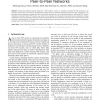122
click to vote
TKDE
2010
14 years 7 months ago
2010
DHT is a widely used building block for scalable P2P systems. However, as uniform hashing employed in DHTs destroys data locality, it is not a trivial task to support complex queri...
119
Voted
SIGMETRICS
2010
ACM
14 years 7 months ago
2010
ACM
This paper builds a complete modeling framework for understanding user churn and in-degree dynamics in unstructured P2P systems in which each user can be viewed as a stationary al...
122
Voted
CORR
2011
Springer
14 years 7 months ago
2011
Springer
Contemporary use of the term ’intension’ derives from the traditional logical doctrine that an idea has both an extension and an intension. In this paper we introduce an intens...
119
click to vote
INFOCOM
2010
IEEE
14 years 10 months ago
2010
IEEE
Misconfigured P2P traffic caused by bugs in volunteer-developed P2P software or by attackers is prevalent. It influences both end users and ISPs. In this paper, we discover and stu...
BIRTHDAY
2010
Springer
14 years 10 months ago
2010
Springer
In this paper we discuss requirements for peer-to-peer (P2P) benchmarking, and we present two exemplary approaches to benchmarks for Distributed Hashtables (DHT) and P2P gaming ove...
98
Voted
TPDS
2010
14 years 11 months ago
2010
—Utilizing the skewed popularity distribution in P2P systems, common in Gnutella and KazaA like P2P applications, we propose an optimal resource (replica or link) placement strat...
117
Voted
INFOCOM
2010
IEEE
14 years 11 months ago
2010
IEEE
—Network positioning systems provide an important service to large-scale P2P systems, potentially enabling clients to achieve higher performance, reduce cross-ISP traffic and im...
109
click to vote
COMCOM
2008
15 years 5 days ago
2008
Active worms continue to pose major threats to the security of today's Internet. This is due to the ability of active worms to automatically propagate themselves and compromi...
123
Voted
INTERNET
2002
15 years 8 days ago
2002
Despite recent excitement generated by the peer-to-peer (P2P) paradigm and the surprisingly rapid deployment of some P2P applications, there are few quantitative evaluations of P2...
100
click to vote
PE
2006
Springer
15 years 15 days ago
2006
Springer
In this paper we model and study the performance of peer-to-peer (P2P) file sharing systems in terms of their `service capacity'. We identify two regimes of interest: the tra...






